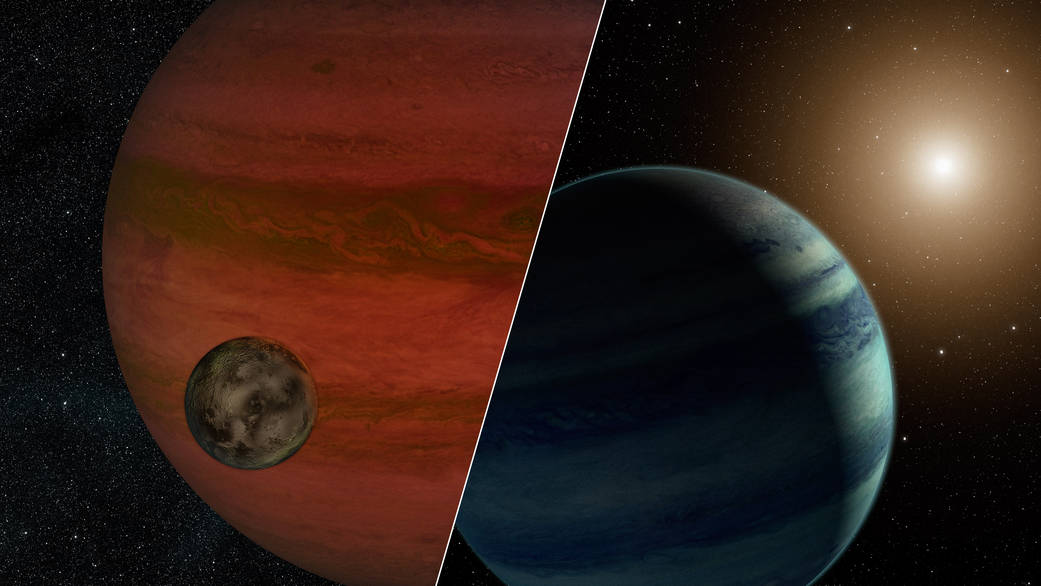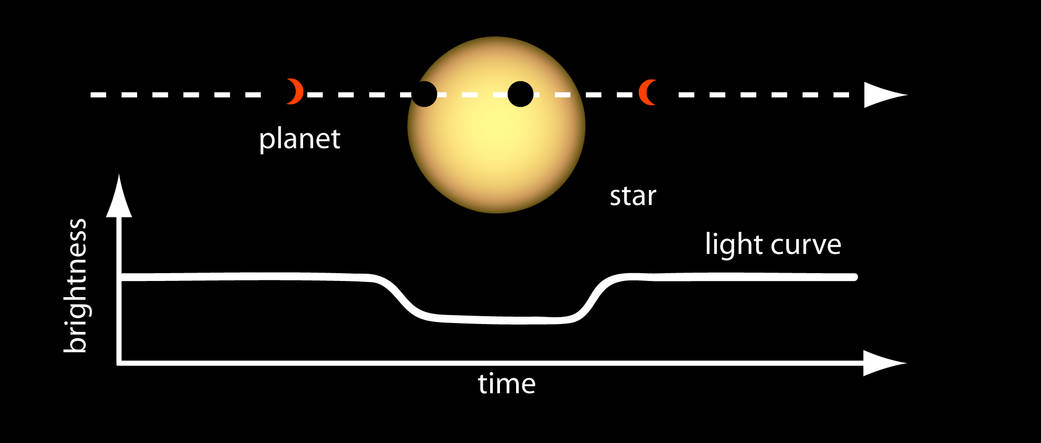New Technique Searches for Exomoons by the Light of Their Planets

Bright, young planets that are still hot from their formation could shine some light on their moons, making the dim satellites easier for astronomers to spot using a newly developed technique.
The new method suggests using the polarization of the light from the planet to find these small moons. Polarization light refers to light waves that are oriented in the same direction. For example, when sunlight reflects off the surface of the ocean, it tends to become polarized.
"When you use polarized sunglasses, you block one direction of the light waves and not the other," Mark Marley, a research scientist at NASA Ames Research Center in California, told Space.com by email. "In our case, as the moon passes over the planet, it sort of acts like polarized sunglasses and blocks part of the polarization from the planet." [The Strangest Alien Planets (Gallery)]
The hunt for exomoons
As the gas and dust around a newborn star collapses in on itself, creating planets and other bodies, it compresses and heats up. Newborn planets carry this heat with them, slowly cooling over time. In their youth, the heat causes the planets to glow in the near-infrared wavelength, a glow that lasts for a few hundred million years, according to Sujan Sengupta, an associate professor at the Indian Institute of Astrophysics, and lead author on the new paper describing the new moon-hunting method.
Sengupta and Marley were curious how that glow could help astronomers find exomoons, the satellites around exoplanets, or those that orbit stars other than the sun. Although gas giants like Jupiter and Saturn aren't habitable, their moons provide some of the best potential sites for finding life in the solar system today. Moons around the giants of other solar systems could also serve as potentially habitable worlds.
One method for finding planets around other stars is known as direct imaging, in which scientists try to capture photographs of the exoplanets themselves. Moons can't be directly imaged, since they are too small, faint and close to their planets.
"It's hard enough to see the planet near its star," Marley said.
Breaking space news, the latest updates on rocket launches, skywatching events and more!
Some planet-hunting techniques look for the indirect effects of a planet orbiting a distant star, such as the planet tugging at the star with its gravity or blocking the star's light.
This latter method can be used to find exomoons as well, if the planet is detected using direct imaging. As an exomoon passes between its parent planet and the Earth, the moon covers up a section of the planet's disk. This has the potential to change how bright the planet appears to Earth-based telescopes. These variations can be extremely difficult to spot, but some researchers are searching for exomoons with this method.
However, the researchers found that if the planet is cloudy, the clouds can polarize the light that the planet radiates, and most gas giants in and out of the solar system have clouds. Spread across a typical spherical planet, the total polarization adds up to zero, Marley said. But when a moon covers up part of the planet, it changes the total polarization. Back on Earth, scientists can detect this change, which, Marely says, is especially strong along the edges of the planet.
"In the right circumstances, it could be easier to detect this change in polarization than the small change in brightness as the moon crosses the planet," Marley said.
The research was published in the Astrophysical Journal.
Setting the stage
Moons around other planets remain a tantalizing possibility because they are so challenging to find. The satellites must be enormous to be directly imaged, or to cause a dip in the brightness of their parent star. While no moons have yet been confirmed outside the solar system, a huntfor them with NASA's Kepler telescope narrowed the range down to about twice the mass of Jupiter's moon, Ganymede. According to Marley, however, the new method could find Ganymede-size satellites with instruments like the upcoming Thirty Meter Telescope, provided the parent planet was the right size.
"The higher the moon-to-planet ratio, the higher the polarization," Sengupta said.
The final factor in the hunt for an exomoon in the polarized light of a planet comes from its oblateness. Planets are not perfect spheres, and carry a bulge around their equator. The faster the planet spins, the more oblate it becomes. The bulge can create asymmetries in the light and give rise to its own polarization issues. According to Sengupta, a perfectly spherical planet without a moon should have no detectable polarization. But when a large moon crosses between its host and Earth, it would block part of the polarized light, revealing itself by the shift.
If the planet carries very little bulge and a medium-size moon, it can make an exomoon detection more challenging, as the effect due to the oblateness would dominate how the cloudy planet is polarized. Slow-rotating planets, like those found in the solar system, should more easily reveal their moons.
"Such high oblateness needs the planet to rotate around its own axis at a period of less than 5 hours," Sengupta said. "Jupiter is the fastest rotator in our solar system, and the rotation period of Jupiter is about 10 hours."
He went on to say that a medium-size moon beyond the solar system could be detected if the planet rotated once every 10 to 15 hours or more.
"It seems likely that the abundance of planetary systems discovered around other stars should also have a significant number of natural satellites or exomoons orbiting the planets," the researchers concluded.
Follow Nola Taylor Redd on Twitter @NolaTRedd or Google+. Follow us at @Spacedotcom, Facebook or Google+. Originally published on Space.com.

Nola Taylor Tillman is a contributing writer for Space.com. She loves all things space and astronomy-related, and always wants to learn more. She has a Bachelor's degree in English and Astrophysics from Agnes Scott College and served as an intern at Sky & Telescope magazine. She loves to speak to groups on astronomy-related subjects. She lives with her husband in Atlanta, Georgia. Follow her on Bluesky at @astrowriter.social.bluesky

